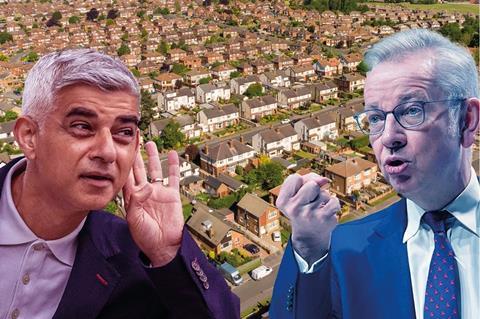Not the “right plan for London?” Or is Gove’s intervention a “desperate political stunt?” Olivia Barber finds out how the mayor’s spatial development strategy become the centre of a spat in this year of multiple elections

Amid an ongoing housing crisis, and with mayoral and general elections looming, Michael Gove has turned his attention to the capital’s spatial development strategy, the London Plan.
In December, the housing secretary accused Mayor of London Sadiq Khan of being too focused on implementing affordable home targets at the expense of overall delivery. He stated that, in the past three years, Khan had delivered just 38,000 new homes every year, 15,000 fewer than the target in his London Plan.
With this, Gove announced that he had appointed a panel of experts to inspect the plan and find any aspects “which could be preventing thousands of homes being brought forward”.
The panel’s “short report” is now with Gove’s department. While we wait for the review’s findings, Olivia Barber dissects Gove’s critiques and asks legal experts to probe the review’s implications.
What is the right plan for London?
At the launch of the new National Planning Policy Framework (NPPF) on 19 December, Gove said that Sadiq Khan’s 50% affordable housing target was “frustrating delivery” and, in some cases, halting development altogether due to viability issues.
He said that Khan’s London Plan “is not the right plan for London”, as it is “dramatically underdelivering”.
While Gove said he was “strongly in favour of affordable and social housing”, Khan’s 50% affordable homes target in every new development was “imposing such significant costs that in many cases development doesn’t go ahead at all”.
This followed a letter from Gove to Khan dated 18 December, when the secretary of state zeroed in on the mayor’s housing delivery records in London. He said that London was the worst-performing region in the Housing Delivery Test 2022, which compares the number of new homes a local authority requires per year with the number delivered in the same time-frame.
Gove added that the average of 38,000 homes delivered was 63,000 fewer homes than the actual need last year.
Last week, Khan branded the review “a desperate political stunt”. The mayor has countered such criticisms on more than one occasion, stating that since he became mayor, London has been outbuilding the rest of England. He went as far as to say that London is delivering twice the number of council homes as the rest of the country.
He also said that London has been delivering more new homes of all types, including more new council homes than at any time since the 1970s, a period in which council housebuilding boomed.
Based on government additional affordable housing supply statistics, London started construction on 10,986 council homes in 2022/23, compared with the 5,146 council homes started in the rest of the country, adding weight to Khan’s claims.
But in terms of completions last year, London delivered 4,418 council homes, while the rest of the regions in England collectively delivered 4,448 council homes.
In 2021/22, London completed 3,016 council homes, compared with the 4,771 council homes delivered in the rest of the country. When it comes to affordable housing delivery overall, last year registered providers (RPs) in London made starts on 15,391 affordable homes and delivered 11,260 homes, this compares to 34,546 and 38,584 respectively elsewhere in England in 2022/23.
Regarding the claim that London is outbuilding the rest of the country, government data on dwelling stock indicates that London’s housing supply has increased by 8% since 2016, while in the rest of the country, the figure went up by 6.5% from 20,093,000 to 21,407,000.
Gove: “I reserve the right to intervene”
When Gove announced his review into the London Plan last month, he emphasised that, if Khan could not deliver the number of homes London needs, he would.

Simon Ricketts, a partner at Town Legal, explained that Gove has legal powers to intervene in the plan in “two directions”.
Firstly, under section 337 of the Greater London Authority Act 1999, once the mayor has produced a draft of the London Plan, the secretary of state can make a direction that the mayor cannot publish it if there is “any inconsistency with current national policy”.
As the government’s target is to build 300,000 new homes per year, Gove could argue that Khan’s failure to meet the 53,000 homes target in his plan is not consistent with current national policy.
Ricketts said that, in theory, if Gove could evidence that Khan’s affordable housing requirement is not viable, or is otherwise holding back delivery, he could even reduce the target.
Ricketts said that by launching a review into the London Plan before the mayoral election in May, Gove is seeking to influence the next version of the London Plan, which tends to be updated at the start of a new mayoral term.
Secondly, though not all relevant sections are in force yet, under the Levelling-Up and Regeneration Act 2023 the secretary of state will now have further powers to intervene in the London Plan.
Under the act, the secretary of state can prescribe “further matters the spatial development strategy may, or must, deal with”. Ricketts said. “I think Gove will aspire to a much slimmed-down plan which focuses on truly ‘strategic’ matters”.
Ricketts said: “Ultimately, he [Gove] can call the shots, he will be able to indicate things which the plan must deal with. And, once the plan or draft is published, he can direct changes to be made.”
“That is what he has got up his sleeve”, he added.
Regarding Gove’s focus on brownfield sites in London, Ricketts said: “We have yet to see what Gove is doing nationally to further encourage development on brownfield sites, but he will certainly be looking to make sure the London Plan approach is consistent.”
Nicola Gooch, a partner at Irwin Mitchell, noted that the “potential political angle” to Gove’s review into the London Plan is not to be underestimated. She also suggested that Gove was “looking for ammunition and leverage”, as well as “to see what can be done with a view to influencing the future direction of the plan”.
I think Gove will aspire to a much slimmed-down plan which focuses on truly ‘strategic’ matters”
Simon Ricketts, partner at Town Legal
While Gove’s critique of the plan was primarily focused on Khan’s high affordable housing targets, Kamran Hyder, partner and head of the planning team at Ward Hadaway, said: “The requirement for affordable housing is here to stay, particularly in places like London, where high house prices are more acutely felt.”
He added that “there may be cases where the ask for affordable housing is too big and the scheme has to be abandoned,” but that for Gove to blame Khan for obstructing development was “too simplistic” and more about “political expediency”.
Hyder added that the intention behind the review seems to be to put pressure on the mayor prior to the election.
He said that the only mechanism by which Khan could challenge the secretary of state’s intervention in the London Plan would be by judicial review, and that Khan’s lawyers would certainly look closely at the findings of the review and challenge them if unwarranted.
Alistair Smyth, director of policy and research at the National Housing Federation, said: “Barriers to developing social rented homes, the most secure and affordable homes for low-income families, have been similar both in London and across the country. In 2010, the government cut funding for affordable housing by 63%, the biggest cut to any capital budget at the time.
>>See also: London mayor failing to provide enough affordable homes, Gove says
>>See also: London mayor mandates second staircases in blocks above 30m ‘with immediate effect’
“This has led to a drastic fall in the number of new social homes being built. Last year only 8,386 social rent homes were built, 76% fewer than in 2010. We need to build 10 times this number each year to house those in need across the country.
Smyth added: “Housing associations are projecting a drop of 16% in new development over the coming five years compared with its five-year projection from a year ago due to cost and funding pressures. This crisis has been decades in the making and is the result of successive short-term, piecemeal approaches to housing policy and planning.

“As we head towards the election, we need all political parties to commit to a properly funded, nationally coordinated, long-term housing plan that aims to transform the health, economic security and life chances of millions.”
While the recommendations of the review are yet to materialise, it is clear from Gove’s NPPF speech last month – in which he spoke about taking action against councils that have failed to produce a local plan and driving growth in London and Cambridge – that he is poised to intervene. Furthermore, he will be equipped with additional powers in the Levelling-Up and Regeneration Act to enable him to do so.
Up until this point, Gove has used language to show that he means business, but whether that will be followed up with changes such as the watering down of affordable housing requirements in the London Plan remains to be seen.
Nonetheless, as Gooch said, “housing has become an incredibly political issue”. And, in a year of elections in City Hall and Westminster, it seems a given that this dispute will only continue.



























No comments yet